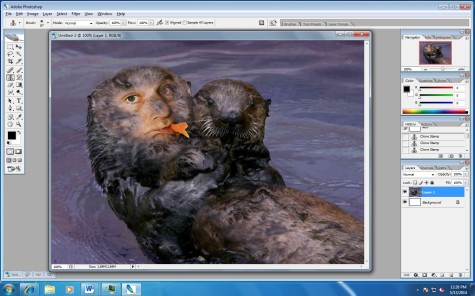Photoshop wrongfully rejected, student says
May 13, 2014

As little as I get on Facebook, it has not escaped notice the campaign that seems to have broken into the ever-expanding rink of online protest.
Victoria’s Secret, Target, this magazine and that medium for online perusing have all been condemned in its wake. Those companies that have not been called out specifically compete to see exactly who best can right the wrongs prevalent through the industry. Underneath, in that little white box usually reserved for ignorance, political rants and cultish rages that elicit that groan of having lost faith in humanity, people rally against the pure undiluted evil that falls under the umbrella name of “Photoshop.”
And along the way a reputation is tarnished.
Photo editing in advertising is a given, something that has happened since cavemen began to banner their accomplishments across the walls of their simple homes. Waistlines are whittled, breasts boosted, abs accentuated, complexions complimented and blemishes blotted out. Edits are made to look better than reality, closer to the ideal that changes more or less with every generation.
It is detrimental, yes: harmful to the ideas of a public that flocks to worship the celebrities that play sovereign to our society. But it is by no means the fault of the program or even the company which produces it. Rather, like murder, the blame should fall on those who call the shots.
Those who wield its power with the unruly and irresponsible selfishness many modern advertisers display profane the name of something that is, intrinsically, an innovative and positive technology. Photoshop does not have to be—and is not always—used to degrade the masses or to raise the standards of aesthetic beauty.
Photoshop and other photo editing programs can be used to restore photographs otherwise long gone, stained and torn and burned by forces hardly anyone remains to remember. It can be used to make art, to design movie posters, to set out the bounds of typography for things we use everyday. Its uses extend only as far as the intersecting bounds of a computer’s memory and a user’s imagination. Filters on Instagram are essentially of the same DNA strain that so many users have condemned, technology to make our photographs look better than our skills might have managed.
But the use that most often comes to light is, unfortunately, the most negative. Photo-editing is used to shave model’s bodies down to toothpicks and viewer’s esteem to even less. Target was recently admonished by the community for even going so far as to delete a square of image at a model’s crotch to accentuate that THIS BLESSED SWIMSUIT MIGHT ACTUALLY GIVE YOU A THIGH GAP. (A little square one that makes you look like you’ve been straddling a metal girder for 313 hours.)
And those companies that rebel with “natural models”— women (and men, I guess?) posing in minimal makeup, cellulite and flyaway hairs perfectly visible—are praised for having thrown off the burden that is photo editing.
This is what the public is fed and this is what they see, leading us not to consider the very specific motives of what we see but rather to blame that which makes it possible. And this is what taints the essence of what Photoshop is, riling the media to speak out against it as a whole, ignoring the crucial fact that it is not the weapon that fires the shots, but the hands of those who seek to use it recklessly to their own ends. It is not the gun, but the ammunition, and those who pull the trigger against us will likely cease only with the change in attitude.

